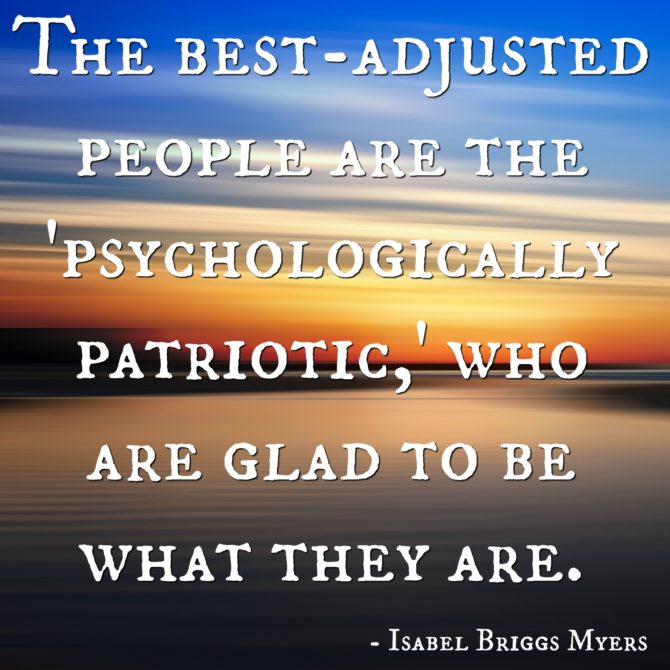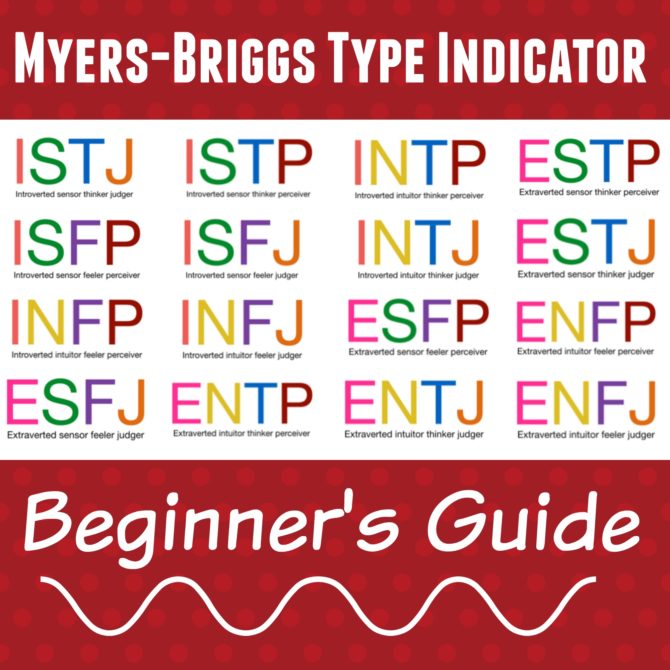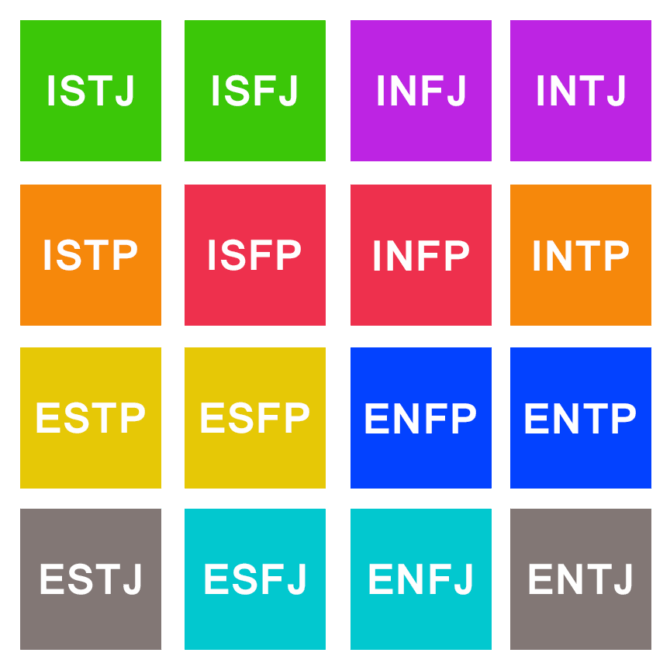We’ve all had experience with transient hobbies—those pastimes we pour ourselves into for a time, but eventually prove to be short lived diversions. I’ve had many of these temporary interests, and I keep expecting my obsession with personality models to become one of them. The subject has yet to lose its luster for me, though; what I thought might be a fleeting pastime has proven to have some staying power. The more I read and learn about various personality models, the more intrigued I become. I just can’t get enough!
Of course, my enthusiasm extends beyond simply studying these models. I’ve acquired quite a bit of information, and I can’t help but try to apply it all to my own little worlds. It’s become nearly impossible for me to keep from interacting with people—in real life and also guests on podcasts and characters in shows and books—without trying to “type” them! During our introductions with my new Bible study small group a few weeks ago, we were asked to share something interesting about ourselves; of course I shared my interest in personality types, and warned the girls that in getting to know each other I would likely be trying to piece together each of their personality styles. (And if that creepy statement didn’t scare the new girls away, I don’t know what will!)

Since my passion for all things personality remains strong, I’ve decided to take you along with me on my exploratory journeys through this vast subject. Today’s post is the first in a miniseries I will be doing on some of the most popular personality models. There are countless personality frameworks designed by experts to help us categorize everything from our organizational styles to our spirit animals, but this series will focus in on the models I’ve personally found most useful. I’ll give you a brief overview of the models, as well as links to quizzes you can take to determine your own style. I’ll also direct you to other resources for those of you who are interested in delving deeper!
Before We Begin . . .
If you haven’t already been bitten by the personality bug, you might be tempted to skip this series, but let me try to convince you otherwise. There are a number of reasons to study personality models: not only are they fascinating for their own sake, they are also incredibly useful.
Knowing more about your personality can help you understand and embrace aspects of yourself that you might not have been aware of, and it can help you identify areas that can use some extra work or support. For me personally, exploring personality models has helped me become more confident by helping me to accept parts of myself that I don’t necessarily like but now realize are simply part of who I was made to be.
An awareness of the personality types of people around you is also beneficial, allowing you to bypass conflicts that stem from the general misunderstanding of another person’s genetic makeup. When we understand why our loved ones behave differently from us, or how their perspective differs from our own, we are much more willing to extend grace for behavior that would otherwise have been interpreted as inconsiderate or simply bizarre.
. . . And We’re Back!
Now that you’re hopefully on board with the notion that personality models are totally worth your time, let’s get started! We’re kicking off this series with my first and deepest love when it comes to personality models: the Myers-Briggs Type Indicator! The MBTI is the model I know the most about, and the one that has been most helpful for me in understanding others. It was developed in the years following WWII by Katherine Cook Briggs and her daughter Isabel Briggs Myers, and is based on theories of Carl Jung who believed that much of the seemingly random variation in human behavior is actually quite consistent, due to basic differences in how people prefer to use their perception and judgement. Myers-Briggs focuses on how you prefer to behave, and not necessarily how you always behave.

The MBTI identifies sixteen different types, each consisting of four different letters indicating your preference in the following areas: Extraversion (E) or Introversion (I), Sensing (S) or Intuition (N), Thinking (T) or Feeling (F), and Judging (J) or Perceiving (P). Below is an explanation of what those four key letters actually represent.
E (extroversion) or I (introversion): How we gain our energy.
Extroverts turn their energy toward the outer world of activity and spoken words, while Introverts turn their energy toward the inner world of thoughts and emotions. A common misconception is that Introverts are reclusive and Extroverts are always social, but these are broad generalizations: Introverts might enjoy social gatherings even though they find them draining, and while Extroverts are energized by being around others, they often still find they need their alone time.
- Traits associated with Extroverts:
- Gain energy from being with others.
- Seen as outgoing or easy to get to know.
- Comfortable working in large groups.
- Prefer having a wide range of relationships.
- Tend to make decisions quickly and act before thinking.
- Clarify thoughts through speaking.
- Traits associated with Introverts:
- Are energized by being alone.
- Perceived as more reflective or reserved.
- Comfortable working independently.
- Prefer having a few close relationships.
- Tend to move slowly in making decisions or taking action.
- Clarify thoughts internally.
S (sensing) or N (intuition): How we take in information.
Sensors process information in the form of facts and familiar terms. They pay attention to their physical reality and what they take in through their five senses, and they are most concerned with what is actual, present, current, or real. Intuitives process information in the form of possibilities or new potential, paying more attention to the impressions and meanings of that information. Intuitives are more comfortable dealing with abstract concepts than specific facts.
- Traits associated with Sensors:
- Process information through their five senses.
- Remember specific details of past events.
- Solve problems by working through facts.
- Practical, factual, and realistic.
- Trust experience over impressions.
- Traits associated with Intuitives:
- Process information through patterns.
- Remember events by the impressions they made.
- Solve problems by leaping between ideas and possibilities.
- Idealistic, theoretical, and inventive.
- Trust impressions and symbols over experience.
T (thinking) or F (feeling): How we make decisions.
Thinkers make decisions based on logic and objective facts, while Feelers give more weight to personal values and people involved. Feeling is not the same as emotion, and Thinking is not the same as intelligence; Thinkers are not insensitive, and Feelers are not irrational. We all use Thinking to make some decisions and Feelings to make others, but we have a preference for one or the other.
- Traits associated with Thinkers:
- Oriented towards technical or scientific fields where logic is important.
- Analytical, objective, and task-oriented.
- Make head-based decisions and prioritize fairness.
- Believe telling the truth is more important than being tactful.
- Often perceived as impersonal and indifferent.
- Traits associated with Feelers:
- Oriented towards people and communication.
- Passionate, personal, and empathetic.
- Make heart-based decisions and prioritize relationships.
- Believe tact is more important than communicating the cold truth.
- Often perceived as too idealistic or indirect.
J (judging) or P (perceiving): How we structure our outer world.
Judgers prefer to organize their lives in a structured way, making firm decisions and knowing where they stand. Perceivers are more flexible and like to discover life as they go along. These functions describe the face we show to the world: a Perceiver might feel structured on the inside, but their outer life looks spontaneous and adaptable, and a Judger may feel curious or open-ended on the inside, but their outer life is more orderly and decided.
- Traits associated with Judgers:
- Like closure and having things decided.
- Prefer to finish one thing before moving to the next.
- Controlled, organized, and structured.
- Tend to work at a steady pace.
- Like making and sticking to plans and lists.
- Traits associated with Perceivers:
- Like to stay open-ended.
- Start many things without finishing them.
- Flexible, disorganized, and spontaneous.
- Tend to procrastinate and work in bursts of energy.
- Like to approach tasks as a mix of work and play.
The ways in which these four functions interact with each other form the basis of the sixteen distinct personality types. You might have heard these types described by different names, but ultimately the types come down to those four key letters.
There is SO much more we could get into here regarding the interplay between the various functions, why and how the different types can be confused with one another, and the general type preferences among genders and people groups. But hopefully this overview has given you a basic understanding for the four cognitive dichotomies and what they represent.

Take the Test: After reading over the descriptions above, you likely have a good idea of what your four-letter type might be, but if you’re still not sure and would like to confirm your type, I’d encourage you to take a test (and while you’re at it, have your loved ones take one too!). The most accurate way to discover your Myers-Briggs type is by taking the MBTI Indicator with a certified administrator, but there are a number of places to take a less vigorous version of the test online. I like this test from 16 Personalities, as well as this one from Personality Hacker.
Learn More: My favorite resource for learning about Myers-Briggs is Personality Hacker. They have an awesome website where you can read in-depth articles and listen to podcasts about each of the sixteen different types. They even include lists of resources for each type, such as books or movies that might be intriguing for your exact type and specific topics your type may be interested in exploring. (It should come as no surprise that Myers-Briggs is listed as the most popular topic for my INFJ type!) I also really enjoy the Personality Hacker podcast; it doesn’t exclusively focus on Myers-Briggs, but they do discuss the topic pretty regularly.
Another great online resource is Personality Junkie, where you’ll find a number of type-specific articles, personality tests, and e-books on Myers-Briggs and the sixteen types.
I haven’t had much luck with print books about Myers-Briggs; I’ve only read a couple, and neither were titles I would really recommend. There seems to be a lot more information about this topic online. If you’d prefer to read a book on the topic, Goodreads has a list of the 75 most popular books about or related to the MBTI. However, I haven’t read most of the books on the list, so I can’t vouch for the accuracy or relevance.
One of my favorite ways to have fun with the MBTI and feel solidarity with others of my type is to search “INFJ” on Pinterest and explore the results. It’s totally nerdy, I know, but a lot of fun!
And there you have it! I hope you’ve enjoyed this brief tutorial as much as I enjoyed putting it together. If you have any questions, feel free to ask them in the Comments. I might not know the answer, but I’ll probably now how to help you find it! And I hope you will join me next Wednesday as we explore our next personality model, The Enneagram!
[…] MODELS — This one is certainly no secret. Myers-Briggs is still my “specialty” but I’m growing to love the Enneagram almost as much. I […]
[…] know is that I enjoy tracking my reading progress almost as much as I enjoy reading itself. With my INFJ personality and my predilection for rigorous documentation of all aspects of my life, an overzealous enthusiasm […]
[…] I had putting together beginner’s guides for three of the most popular personality frameworks (Myers-Briggs, The Enneagram, and The Big Five). Today, in the spirit of the book theme I have going on for the […]
[…] through some of the more popular personality models. The last two personality systems we discussed (Myers-Briggs and The Enneagram) were both models I’ve studied quite a bit on my own. Today we’re […]
[…] week we kicked off our personality series with an introduction to the Myers-Briggs personality model. I loved all of the great feedback I received and was excited to see how many of you are […]